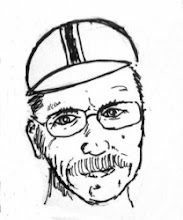 I've often said that if there was one perfect bicycle saddle we'd all be riding it. The truth of the matter is bikes are different, riders are different, riding positions are different, riding styles are different and guess what? Different saddles work better or worse for various folks. That said, if you hang out with high mileage folks you'll find a lot of them who swear by Brooks saddle
I've often said that if there was one perfect bicycle saddle we'd all be riding it. The truth of the matter is bikes are different, riders are different, riding positions are different, riding styles are different and guess what? Different saddles work better or worse for various folks. That said, if you hang out with high mileage folks you'll find a lot of them who swear by Brooks saddleBrooks are tensioned leather saddles. Sheldon Brown has a great article describing the great comfort virtues of leather saddles here. Sheldon notes, "A leather saddle, like a good pair of shoes or a baseball glove, softens with use, and molds itself to fit a particular person's shape." The unique comfort factor is what makes the saddle worth the expense, weight and break-in period. However, if you're a vegan, that dead cow thing may be a deal breaker for you. I totally expect some entrepreneurial vegan to start a company making a Brooks-style saddle made of tensioned rattan (or some other sustainable, eco-vegan substance) any day now. It's an untapped market.
What prompted me to write this piece, despite Sheldon's excellent article on leather saddles and his wise words on saddles in general, is that I wanted to call attention to the issue of saddle set-back. One of the virtues of Brooks saddles is their classic design, they have basically remained unchanged for decades. And there, my friends, literally, is the rub.
Brooks saddles were designed when bikes had much slacker seat tube angles than what is common today. My 1972 Peugeot PX-10 was considered "racy" in its day and it had a 72 degree seat tube angle. It was easy to get a Brooks saddle back far enough in relation to the bottom bracket for comfortable riding. A modern bike, say a Surly Long Haul Trucker, in the same 52 cm size as my PX-10 has a 73.5 seat tube angle. Basic trigonometry tells us that given the same seat post but a steeper seat tube angle, the clamp area is going to be further forward on the modern bike. Modern saddles have longer rails to address this issue but the classic design of the Brooks keeps it from moving back. And if the saddle is too far forward, you'll tend to sit on the metal frame rather than the tensioned leather and wonder why anyone could ever think a Brooks saddle is comfortable.
There are some solutions out there. Velo Orange makes the Grand Cru Seat Post specifically with this problem in mind. A Brompton Saddle Adapter Pin used with a straight post and a seat clamp allows even more adjustment but it's a more complex solution. Sella Anatomica makes a couple of changes to the classic Brooks design, adding a cutout to the leather and longer rails to address the set-back issue. Like Brooks saddles themselves, the Sella Anatomica saddles have received mixed reviews.
A comfortable saddle is key to enjoying your bicycle riding and a Brooks or other leather saddle might be just right for you. If you can get it on the right spot on your bike.
BTW, I've logged thousands of miles on Brooks saddles, having ridden them on PBP, BMB and various other brevets and tours. These days, my butt is totally happy on WTB saddles but your mileage may vary.
Keep 'em rolling,
Kent "Mountain Turtle" Peterson
Issaquah WA USA















